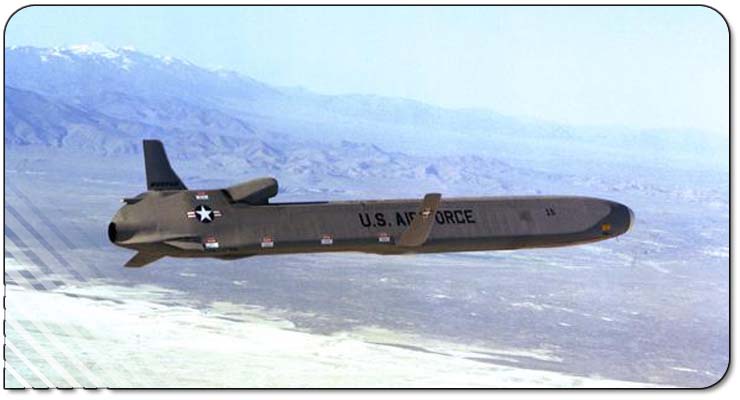Description:
Mission: The
AGM-86B air-launched cruise missiles and
AGM-86C/D conventional air-launched cruise missiles were developed to
increase the effectiveness of B-52H bombers. In combination, they
dilute an enemy's forces and complicate defense of its territory.
Features: The
small, winged AGM-86B/C/D missile is
powered
by a turbofan jet engine that propels it at sustained subsonic speeds.
After launch, the missile's folded wings, tail surfaces and engine
inlet deploy. The AGM-86B is then able to fly complicated routes to a
target through use of a terrain contour-matching guidance system. The
AGM-86C/D uses an onboard Global Positioning System coupled
with its
inertial navigation system to fly. This allows the missile to
guide
itself to the target with pinpoint accuracy.
AGM-86B/C/D missiles increase flexibility in target selection. AGM-86B
missiles can be air-launched in large numbers by the bomber force.
B-52H bombers carry six AGM-86B/C/D missiles on each of two externally
mounted pylons and eight internally on a rotary launcher, giving the
B-52H a maximum capacity of 20 missiles per aircraft.
The AGM-86C CALCM differs from the AGM-86B air launched cruise missile
in that it carries a conventional blast/fragmentation payload rather
than a nuclear payload and employs a GPS aided INS.
An enemy force would have to counterattack each of the missiles, making
defense against them costly and complicated. The enemy's defenses are
further hampered by the missiles' small size and low-altitude flight
capability, which makes them difficult to detect on radar.
Background: In
February 1974, the Air Force entered into
contract to develop and flight-test the prototype AGM-86A air-launched
cruise missile, which was slightly smaller than the later B, C and D
models. The 86A model did not go into production. Instead, in January
1977, the Air Force began full-scale development of the AGM-86B, which
greatly enhanced the B-52's capabilities and helped America maintain a
strategic deterrent.
Production of the initial 225 AGM-86B missiles began in fiscal year
1980 and production of a total 1,715 missiles was completed in October
1986. The air-launched cruise missile had become operational four years
earlier, in December 1982, with the 416th Bombardment Wing, Griffiss
Air Force Base, N.Y., which deactivated when the base closed in
1995.
Besides its initial basing at Griffiss, the ALCM has also been based
at: Grand Forks AFB, N.D., Wurtsmith AFB, Mich., Fairchild AFB, Wash.,
Eaker AFB, Ark., and Carswell AFB, Texas. The ALCM is
currently
fielded at Minot AFB, N.D., and Barksdale AFB, La.
In June 1986 a limited number of AGM-86B missiles were converted to
carry a high-explosive blast/fragmentation warhead and an internal GPS.
They were redesignated as the AGM-86C CALCM. This modification also
replaced the B model's terrain contour-matching guidance system and
integrated a GPS capability with the existing inertial navigation
computer system.
The CALCM became operational in January 1991 at the onset of Operation
Desert Storm. Seven B-52s, from Barksdale AFB, La., launched 35
missiles at designated launch points in the U. S. Central Command's
area of responsibility to attack high-priority targets in Iraq. These
"round-robin" missions marked the beginning of the air campaign for
Kuwait's liberation and are the longest known aircraft combat sorties
up to that time (more than 14,000 miles and 35 hours of flight).
CALCM is a long-range standoff weapon that has been employed
effectively in combat in Operation Desert Storm, Desert Strike, Desert
Fox, Operation Allied Force, Operation Enduring Freedom and Operation
Iraqi Freedom.
In 1996, 1997 and 2001, 200 additional CALCMs were produced from excess
ALCMs. These missiles, designated Block I, incorporate improvements
such as a larger and improved conventional payload (3,000 pound blast
class), a multi-channel GPS receiver and integration of the buffer box
into the GPS receiver. The upgraded avionics package was retrofitted
into all existing CALCM (Block 0) so all AGM-86C missiles are
electronically identical.
The final 50 missiles that were converted from the AGM-86B are the
AGM-86D.
The AGM-86C/D were previously based at Fairchild AFB, Wash., and are
currently fielded at Barksdale AFB, La., and Andersen AFB, Guam.
|
|

